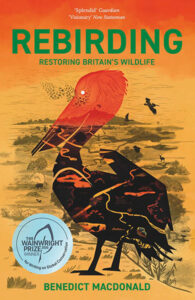
Book Review:
Benedict MacDonald
Rebirding – Restoring Britain’s Wildlife
Driving along the motorway in the summer used to result in lots of fly kill on your windscreen. Not anymore. What has happened? It is not just the insect population that is disappearing. Over the centuries and recent decades, the decline in birds, animals and plant life across Britain has accelerated. It is not because the countryside is covered in houses – only 6% of our land is built on. There is plenty of space to restore wildlife and transform some of our deserts to places where nature can thrive.
It may seem strange to think that we have deserts in the UK. Sadly, there are plenty of examples in our landscape of human impact that has created environments suitable for crops, or grazing animals, or birds for shooting and not much else. Benedict MacDonald is a conservationist who recognises the economic realities of life and seeks to bring nature and ecotourism together to rejuvenate both wildlife and local communities.
The book starts by setting out what Britain would have been like and how the growing influence of human activity has turned our countryside into small islands of land being conserved for their wildlife habitat. Many innovations from mechanical mowers, the end of crop rotation thanks to artificial fertilizers, hedge removal, draining wetlands, to the burning heather on shooting estates have all contributed to the large scale change for our wildlife. Habitats that create the food chain for our birds have been altered to the extent that now many birds are rare or extinct in this country. “The majority of our birds – evolved in wooded grasslands, river valleys and uplands, dependent on insect food chains and landscape dynamism – have little future at all.”
Yet there is hope. One example where things could change to improve the variety of wildlife is within the vast tracks of land of our National Parks. The New Forest is a good example where protection of a wooded landscape allows lesser spotted woodpeckers to thrive. On the wooded fringes of Dartmoor there remains a healthy, although declining, critical mass of cuckoos. There are some interesting photographs in the book comparing different landscapes from the UK and abroad to show what is possible through thoughtful changes.
The second part of the book challenges current practice in particular areas – Welsh hill farming, deer estates in Scotland, the grouse moors, and the Somerset levels, arguing that a reintroduction of significant wildlife would boost tourism and bring more employment than the current economic models. Not all will agree with what is an idealistic view, but the status quo is not sustainable either for nature or local communities.
The final chapter sets out eight rules mainly aimed at policy makers that will help conserve our wildlife. Perhaps the one that speaks to us as individuals is to allow nature to do the work and that scruffy parts of our gardens, villages and cities are a good thing. Thought provoking and an insightful read.
Review by Mike D Williams